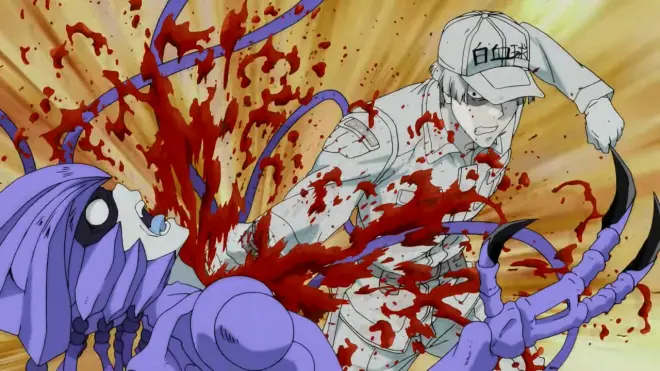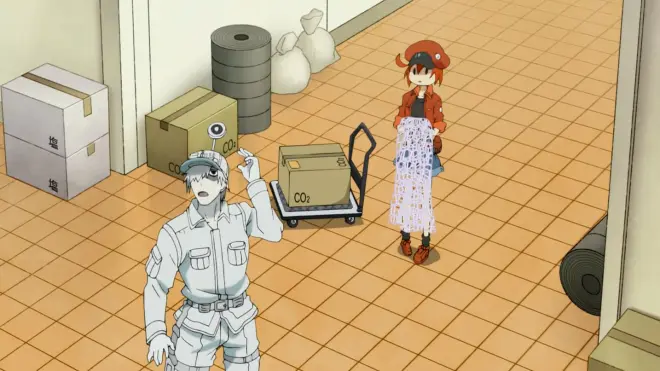医生看工作细胞(一)
本贴的原文来自reddit论坛,作者brbEightball,是位在培医生。
原帖地址为:https://www.reddit.com/r/anime/comments/8z6vpb/hataraku_saibou_ep_1_doctors_notes/
我在这里只是翻译作者的原文,顺便标注下专业的生物单词。
喜欢看‘工作细胞’和喜欢生物的小伙伴可以读一下,本文绝对硬核科普。


Episode 1 - Pneumococcus
第一集:肺炎球菌
主角介绍:
Red blood cell (erythrocyte)
红血球(红细胞)
Red blood cells are the fundamental oxygen-carrying unit of blood. They are normally quite small (7.5 microns), and have a characteristic biconcave disc shape, which allows them to squeeze through tiny capillaries.
红血球运送血液中的氧气。它们非常非常小(7.5微米),它有特别的凹造型技巧,两则都凹下去,这种形状让她们能挤过狭窄的毛细血管

They are extremely numerous—on the order of 20 to 30 trillion cells in the average 70kg adult—and very simplistic in structure. Essentially, they are sacs filled with hemoglobin (a protein which famously contains an iron atom for the binding of oxygen) as well as a few other enzymes and cytoskeletal elements. They do not even contain nuclei, which almost all cells in the human body otherwise do. A downside of this feature is that red cells are generally unable to repair themselves or really respond to any sort of stressors, as nuclei house the DNA and transcriptive mechanisms necessary to express proteins.
它们个数超多,在一个70kg的成年人身体里,有大约20万亿~30万亿个红血球。它们的结构也很简单,就是个包着血红蛋白的袋子(血红蛋白里含有铁元素,可以用来结合氧气),还含有一些酶和细胞质骨架。和人体内其他细胞不一样,红血球没有细胞核。这让它极其弱鸡,它无法自我修复,也没法回应任何外界反应,因为必须要有细胞核里的DNA,才能产生表达。
Once a red cell is formed, its fate is sealed. The average red blood cell survives between 100-120 days in circulation, and is eventually removed from circulation by macrophages, usually in the spleen.
红血球的命运才出生那刻就决定了。红血球的血液循环寿命大概是100-120天,最终会被巨噬细胞(通常在脾里)清理走。

We can infer a few things about her from the first episode. She is obviously new at her job; perhaps it is more accurate to call her a reticulocyte. These are the immature form of red blood cells which still contain some fragments of nuclei from their hematogenesis. So at the very least, we should get a season or two out of her 😊.
第一集里可以看出几点。红细胞是个新手,也许应该叫她‘网织红细胞’,就是红血球的未成熟模式,还残留着一些造血过程中产生的细胞核。所以咧,我们至少能看她出场1季或2季呢。
Additional catch:
另:
Red blood cells jacket are reversible, one side is lighter red, one side is darker red. They change to darker red when carrying CO2, and to lighter red while carrying O2. In reality, this also stands true: blood rich in oxygen is more brightly colored than those with CO2.
红血球的外套可以正反两面穿。一面是浅红,一面是深红。当红血球运送二氧化碳时,颜色是深的,运氧气时变成浅的。现实中,这也是对的:富含氧气的血比含CO2的血颜色要浅



Episode 1 - Pneumococcus
第一集:肺炎球菌
We open to the body of some John (or Jane) Doe. There are 37.2 trillion cells in the body? Sounds about right1.
人类身体里有37.2万亿个细胞?答对了。
A bacterial invasion suddenly takes hold! A colony of pneumococcus invades a vessel. More on them shortly. I want to note that the vessels are represented by structures here, but in reality vascular endothelium is also made of cells (people?). It probably seemed too horrifying to walk through a hallway made of your colleagues however.
忽然,细菌来犯!肺炎球菌的菌落进入血管。一会儿再说它们。我想说的是,尽管动画里用建筑物代表血管,实际上血管内壁也是用细胞(人?!)做的。不过,让你穿过由同事组成的通道,有点恐怖

RBC’s hat reads AE-3803. No idea what that means. I guess I’ll refer to her as that from now on.
红血球的帽子上写的是AE-3803,不知道是啥意思。我以后就这么叫她了。
About pneumococcus. Pneumococcus, also known as Streptococcus pneumoniae, is one of the most common bacterial pathogens. They are gram-positive bacteria. Gram staining is a laboratory technique used in the identification of microbes, using a series of chemical treatments that color the bacteria depending on the chemical composition of their cell walls. “Gram-negatives” stain red, while “Gram-positives” stain blue. Perhaps that’s why these guys are blue.
关于肺炎球菌,也叫肺炎链球菌,是最常见的细菌病原体。它们也是‘革兰氏阳性’细菌。革兰氏染色是一种实验方法,用来区分微生物的。它根据细胞壁的化学组成,来给细菌染色。‘革兰氏阴性’是红色,‘革兰氏阳性’是蓝色。可能这就是为啥这家伙是蓝的。

The neutrophil makes a heroic appearance! His hat simply reads “white blood cell”, but given that he is first on the scene to arrive, we can immediately intuit that he is a neutrophil. Neutrophils are part of the active, non-adaptive immune response. They respond to just about any perceived abnormality, usually attracted by molecular “scents” left by foreign pathogens or by inflammatory chemicals secreted from adjacent cells as a sort of distress signal.
‘嗜中性粒细胞’华丽登场!他帽子上只写着‘白血球’,但是想到他是第一波来的人,就可以肯定它是中性粒细胞。中性粒细胞属于主动的,非适应性免疫反应。它们对任何异常情况都会做反应,它们会追踪病原体留下的‘味道’,或者是追踪细胞发炎时释放出的化学物质。
They exert their bacteriotoxic effects by a complex chemical process known as the respiratory burst. More on that in his character highlight next time. Oh, this guy is called U-1146. One bone to pick: The crunchyroll sub suggests that neutrophils attack bacteria and viruses…in reality they are generally incapable of attacking viruses. Anyways, wtf are these bacteria bleeding? Cytoplasm? lol
它们会释放细胞毒素,这是个复杂的化学过程,叫‘呼吸爆发’。等他下回戏份多时再细讲。哦,这个‘中性粒细胞’叫U-1146。挑个小毛病:字幕里说,中性粒细胞会攻击细菌和病毒。实际上他们基本无法攻击病毒。还有,这些细菌他喵的流的是啥?细胞质??

AE-3803 gets stuck by numerous venous valves. Indeed, your veins have a series of one-way valves that are meant to prevent the retrograde flow of venous blood. Unlike arterial blood, which is vigorously propulsed by your heart’s contraction, venous blood returns at a meandering pace. You may have heard that standing with your knees locked for too long can promote fainting. Indeed, blood can pool down there, and contracting your legs actually squeezes the veins, forcing blood back to your heart thanks to the effect of these valves. When the valves eventually become insufficient (as they do in old age), varicose veins result.
红细胞卡在了静脉瓣上。你的血管里的确有一系列单行道一样的瓣膜,它们阻止静脉血液回流。和动脉血液不一样(它们由心脏收缩推进,流动猛烈),静脉血液就是在闲庭漫步。你也许听说过,如果站着、绷着膝盖的时间太长,就可能导致眩晕。血液会在那里汇集,但是,收缩你的腿会挤压血管,在这些瓣膜的帮助下,迫使血液流回心脏。瓣膜老化后,它们就工作不能了,导致静脉曲张。

Stumbling into the spleen is a very tense scene if you recall that macrophages normally eliminate old or abnormal red blood cells. Look what they do to these red blood cells in a condition known as G6PD deficiency. These are called “bite cells”, because macrophages have literally torn out a chunk of the abnormal red cells.
不小心跑进脾脏很危险啊!还记得吧,巨噬细胞会清理老化或者异常的红血球。看看这些家伙对红血球做了些啥!这个病情叫‘G6PD缺失’。这些红血球叫‘被咬掉的细胞’,因为巨噬细胞真的吃掉了一部分异常的红血球。


I am personally unaware of why a killer cell is stopping AE-3803 from entering lymphatics. They normally should never end up there, but that is mostly due to structure (the lymphatics drain the interstitial tissue spaces, not blood vessels) and not immune effect. However, the lymphatics are a sensitive site for immune surveillance.
我不太了解为什么杀手T细胞会阻止AE-3803 进入淋巴。红细胞一般绝对会在那里出现,这主要是因为位置问题,淋巴是在组织之间,而不是血管之间。但不管怎样,淋巴是重要的免疫监控系统。

Why does AE-3803 get lost so easily? I’m not sure. RBC distribution is driven by laws of fluid dynamics. She does need to make it back to the lungs to deliver her CO2 payload—but this is an artistic license, as red blood cells actually carry very little CO2. Most carbon dioxide is dissolved directly in plasma, usually with the help of an enzyme called carbonic anhydrase. That’s the other major protein that is found in red blood cells.
为啥红细胞这么容易迷路呀我的妈。红血球的流动,是受流体力学推动的(所以不会随意走失)。她的确需要回到肺部送走CO2,但其实红血球只能带一点点、一点点的CO2。大部分的二氧化碳直接溶解在血浆里,这个过程通常需要一种叫‘ 碳酸酐酶’的酶。这是红血球里另外一种重要的蛋白质。
Pneumococcus busts out a special trick—a polysaccharide capsule. Many bacteria express such capsules (staph aureus, anthrax, E. coli) and the medical microbiology textbook I’m scrambling to reference alludes to it as the “most important virulence factor” (feature that facilitates human disease). These layers shield bacteria from immune and phagocytic response, and “acts like a slimy football jersey”2, in that it is hard to grasp and tears away when grabbed by a phagocyte. Furthermore, capsular material can contribute to the formation of biofilms, which make infections extremely difficult to eliminate.
肺炎球菌发动特殊技能 - 多糖荚膜。许多细菌都有这种样子的荚膜(金黄色葡萄球菌,炭疽菌,大肠杆菌),我翻的这本教科书上说它是‘最重要的毒力因子’(即让人染病的东西)。这些膜保护细菌、让它不受免疫系统和病原反应的影响。它就像‘黏黏的美式足球队服一样’,让吞噬细胞很难抓住或者破坏掉它们。另外,荚膜的材质是生物薄膜,这使得感染不好被清除。

U-1146 emphasizes that pneumococci can cause more than just pneumonia. Indeed, they are the most common cause of otitis media (middle ear infection), well really just about any bacterial head & neck infection. They also can alarmingly cause meningitis, a true medical emergency that can kill rapidly due to compression of the central nervous system. Pneumococcal bacteremia, however, is a relatively innocuous term, and simply refers to the presence of the bug in the blood stream. Bacteremia is happening right then, and can be transient and harmless as the pathogen is eventually dealt with. This is known to happen after routine dental procedures, for example. Sepsis is another story, however, and is more like what he is describing. It seems right that “white blood cell HQ” is not sending backup for one lone organism.
U-1146强调说,肺炎球菌不单单能导致肺炎。的确,它们也是中耳炎最常见的原因。基本上,所有和细菌相关的头部、颈部感染里,它都可以掺和下。它们还可以造成非常严重的脑脊膜炎(由于压缩中枢神经导致快速死亡)。但‘肺炎菌血症’就没那么严重,它只是指血液中存在这种细菌。‘菌血症’可以是暂时性的、无害的,因为病原体会被干掉。比如常规的牙医检测后就可能有这种症状。但是‘坏血症’是另一码事,那要严重的多。所以‘白血球总部’没有派出后援来对付这个单独的细菌。

U-1146 has a receptor that helps him detect the bug. This could refer to one of many different pathogen pattern receptors, or PRRs. There are many, which we can go into later.
U-1146自带查细菌的检测器。这可以指某种的‘病原体模式识别受体’。受体有许多种,我们以后再说。

**** platelets! Probably right that they’re ****s children, they are the smallest cells in the body, even smaller than red blood cells. Their chief role is in hemostasis, or clotting. This is an extremely complex and highly-regulated process which merits further discussion later. In short, any damage to vessels (which exposes underlying proteins like collagen and von Willebrand factor) attracts the function of platelets. The fact that they can’t seem to access their calcium stores is very interesting, it may suggest that the host has a storage release disorder. More on that later…
萝莉血小板~ 画成小萝莉挺对的,因为它们是身体里最小的细胞,比红血球还小。它们最主要的作用是止血。这个过程很复杂,需要以后再细说。简单来说就是,一旦血管破损(暴露出下面的胶原蛋白质等),就会吸引血小板运作。它们够不到装“钙”的箱子也很有意思,可能表示主人有storage release disorder(一种血液病,会导致流血时间变长)。以后再说吧。。。


Oh, the Helper T-cell. He is one of the main coordinators of the adaptive immune response, recognizing pathogens and coordinating immune responses. He will famously get taken out by the HIV virus, if that happens later.
哇哦,辅助T细胞。他是适应性免疫反应的重要协调人,可以辨认病原体,并调节免疫反应。他最有名的事迹,就是会被艾滋病病毒除掉。

Cytotoxic T-cells are right to be made so intimidating. They provide immunity especially in destruction of viruses, and will often destroy host cells that they perceive to be infected. Same for natural killer cells, which we will perhaps meet later.
杀伤性T细胞就是该这么吓人。他们杀掉病毒,为人体提供免疫。通常在这个过程中,顺便杀掉被感染的宿主细胞。这个原则也适用于自然杀手细胞(就是御姐‘NK细胞’)
They’re also right, that pneumococcus (and many bacterial organisms) do exhibit hemolysis (destroys RBCs for nutrients), and we can rely on the specific pattern of hemolysis to distinguish different strep species.
肺炎球菌(以及其他许多细菌)的确会‘溶血’(破坏红血球抢夺养分)。我们可以根据溶血的类型,判断链球菌的种类。
The capillaries of the lungs are an extremely tight squeeze, same as the capillaries in systemic circulation. Indeed, RBCs will move single-file here.
肺部的毛细血管超级狭窄,和体循环系统的毛细血管一样。红血球的确只能挨个通过。


Pneumococcus hides in AE-3803’s payload.They take up residence inside RBCs . This image is very telling:
肺炎球菌藏在了AE-3803的箱子,它们的确会藏在红血球之内。从这个图里可以明显看出来。


Neutrophils extravasate (leave the blood vessel) through a very organized and well-described series of mechanisms known as diapedesis. Basically they marginate out to the edge of vessels, then rely on several adhesion molecules to "stick" to the walls of the vessel and then squeeze through.
中性粒细胞需要非常有组织有纪律地离开血管,这个离场过程叫“血细胞渗出”。简单的说,他们贴到血管边缘,利用一些粘性的分子‘粘’到血管壁上,然后挤出去。
The respiratory mucosa, essentially that which lines your airways, features a unique antimicrobial defense—the mucociliary escalator. Basically, pneumocytes contain cilia (tiny hairs) which push mucus and debris up and out of the airway where they can be coughed (or sneezed!) out. I guess the mechanical arms/hands represent the cilia.
呼吸道黏膜,尤其是你气管上的那些,有独特的抵抗微生物的技巧 —— "黏膜纤毛活动梯"。肺细胞上有纤毛(细细的毛),它把肺里的脏东西上推,让人咳嗽/打喷嚏,清理呼吸道。我琢磨着这些机械手臂代表的就是纤毛。

Pneumococcus has the ability to invade through not only blood stream, but also across some type of cell wall due to two enzymes it possess: Pneumolysin, which acts on bronchial cells (which probably get used on this anime), and Hyaluronate lytase, which hydrolizes hyauloran in connective tissue, breaking them down and allowing the germ entry. Bonus animation fact: if you focus on the the last wall that broke, you can see that the edges does not seems like it was only broken, but rather like it was melted too. (18:29 for those want to check).
肺炎球菌不仅可以入侵血管,还可以穿透一些细胞膜,因为它自带两种酶:一种是肺炎球菌自溶酶,作用于支气管上(动画里用的大概就是这种);一种是透明质酸水解酶,它会溶解掉在结缔组织中的透明质酸,破坏结缔组织,使细菌能够进入其中。如果你仔细看动画的话,会发现有部分墙是融化掉的(见下图)。

It's shown in the later chapter that indeed, inside that box were four cylinders of O2 in a steel frame. (hemoglobin is a tetrameric protein consisting of two pairs of identical peptide chains, each of which binds oxygen. So under normal full oxygen circumstances, one molecule of hemoglobin carries four molecules of oxygen)
后面的剧情里可以看到,AE-3803拿的箱子里是4个氧气罐(血红蛋白是‘四’聚体蛋白质,包括两个相同的肽链,每个都可以结合氧气)。也就是,氧气正常的情况下,一个血红蛋白会携带4个氧气分子。


Summary
总结
So, to summarize, this was a pretty humdrum transient bacteremia caused by streptococcus pneumoniae. It seems likely that the host would have manifested no noticeable symptoms from this, and business continues as normal, thanks to our heroes diligent efforts. This probably happens within you on a very regular basis without you ever knowing. Someone asked my opinion of the show--I honestly really like it so far. It doesn't seem like the cast or plot are intended to be incredibly deep, but the creator is clearly passionate about the subject and stays true to form. And it's got people excited about human biology, so I'm sold.
总结下,肺炎球菌短暂入侵了血液。主人应该没有任何明显症状。因为主角们的努力,身体一切正常。这种事八成在你身上很常见,你自己都没意识到。有人问我觉得这部动画怎样,我真挺喜欢的。虽然角色和剧情都不深刻,但是主创们很明显喜欢这个题材,尽量还原真实世界。还让大家喜欢上生物,我爱了爱了。
生物相关单词
Red blood cell 红细胞,又叫‘erythrocyte 红血球’
biconcave 双凹的
hemoglobin 血红蛋白
enzyme 酶
nuclei 细胞核(复数形式)
macrophages 巨噬细胞
spleen 脾
reticulocyte 网织红细胞
hematogenesis 造血过程
Pneumococcus 肺炎球菌
pathogen 病原体
Gram staining 革兰氏染色。区分细菌种类的一种染色方法,革兰氏阳性为蓝色(通常是单层膜),阴性是红色(双层膜)
neutrophil 嗜中性粒细胞
non-adaptive immune response 非适应性免疫反应
cytoplasm 细胞质
venous valve 静脉瓣
venous blood 静脉血
arterial blood 动脉血
varicose vein 静脉曲张
lymphatics 淋巴
plasma 血浆
carbonic anhydrase 碳酸酐酶
pneumonia 肺炎
platelet 血小板
hemostasis 止血
adaptive immune response 适应性免疫反应
Helper T-cell 辅助T细胞
Cytotoxic T-cells 杀手T细胞
virus 病毒
infect 感染
capillary 毛细血管
diapedesis 血细胞渗出
cilia 纤毛

